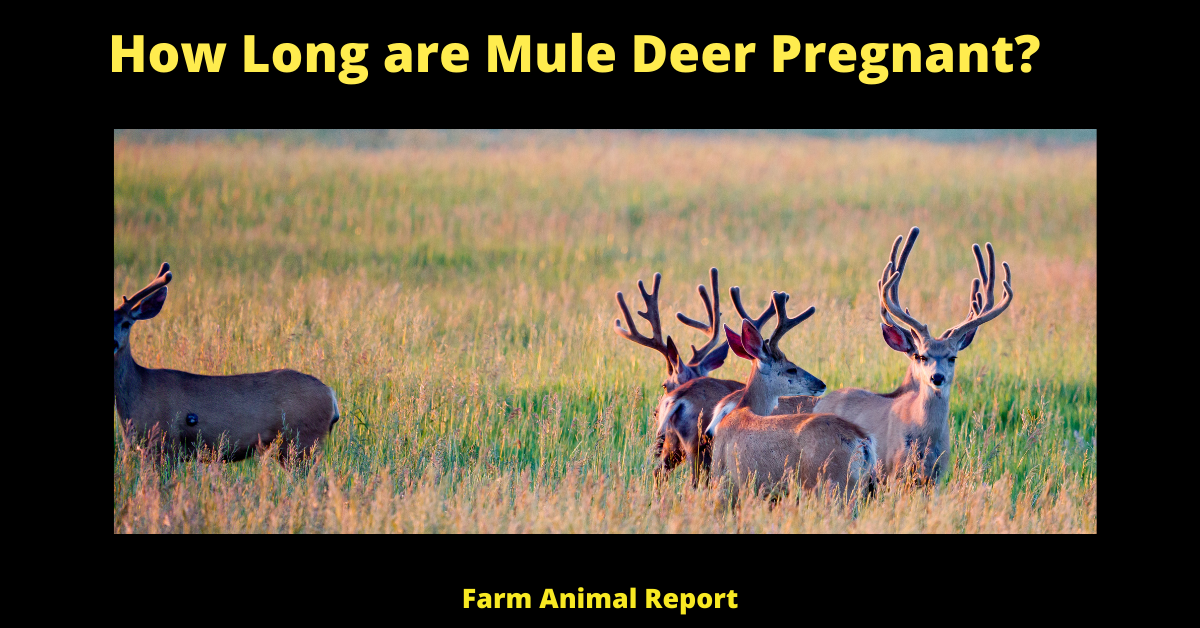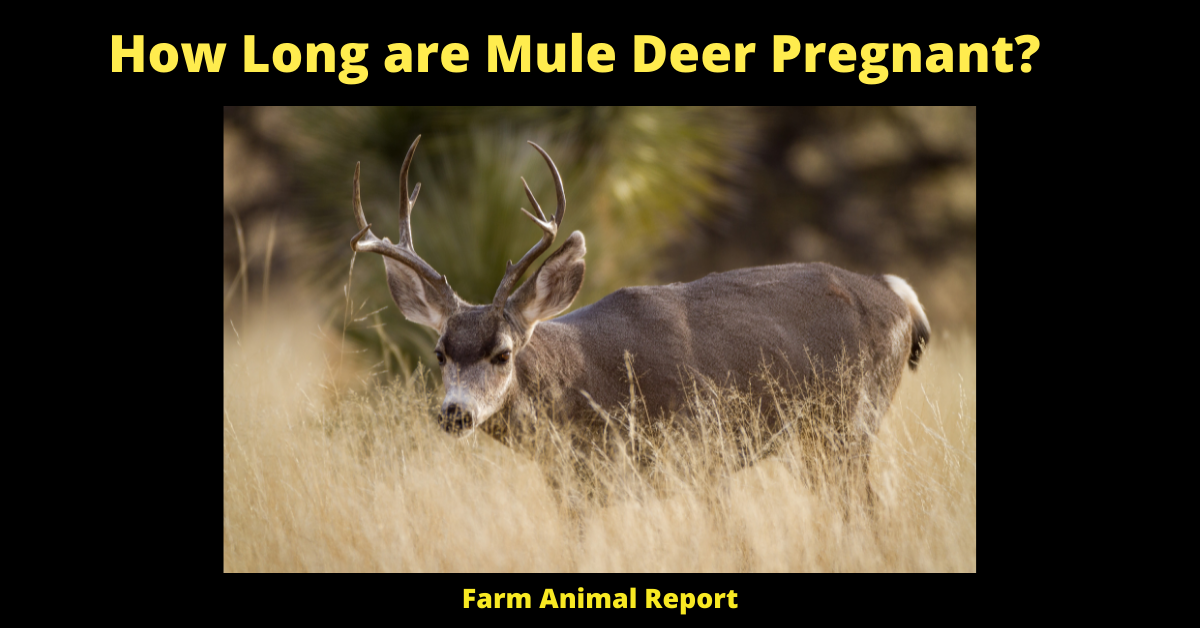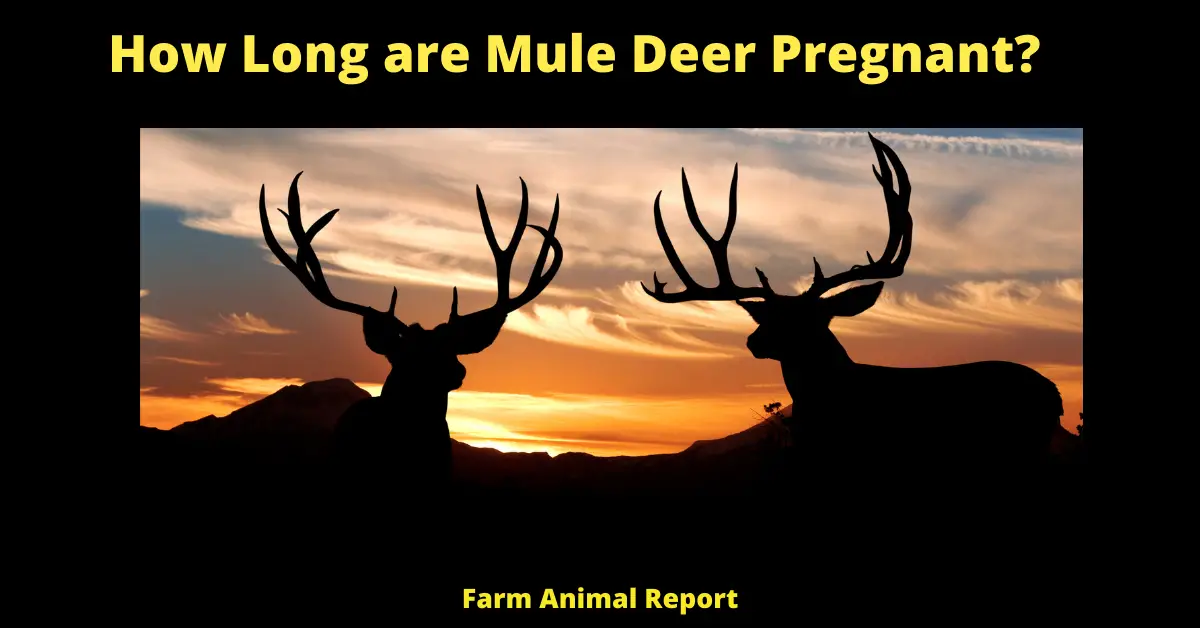Mule deer are pregnant for about 190 to 200 days. She will give birth in approximately 6 months to a single fawn that weighs. Healthy fawns average 4 to 8 pounds at birth, and they will double that weight in approximately 2 weeks — a period during which they survive entirely on their mothers’ milk
Gestation Period for a Mule Deer?
Mule deer are pregnant for about 190 to 200 days, give or take a few weeks. This number can vary depending on the mule deer’s health and nutrition, as well as the climate conditions where they live. In this blog post, we will discuss everything you need to know about mule deer pregnancies! Gestation Period for a Mule Deer?

What is the History of Mule Deer?
The mule deer is a species of deer that is found in western North America. The mule deer gets its name from its large ears, which are similar to those of a mule. Mule deer are reddish-brown in color, and they have whitetails. Jump to How Long Are Deer Pregnant – ( FACTS & PHOTOS)
Mule deer are the most common type of deer in North America. They are found in many different types of habitats, including forests, deserts, and grasslands.
Check Out Amazons Educational Books on Whitetail Deer
Mule deer are herbivores, and they eat a variety of plants. They typically eat leaves, stems, flowers, and fruits. Mule deer also eat some grasses.
Mule deer are prey animals, and they are hunted by many different types of predators. Coyotes, mountain lions, and bears are all predators of mule deer.
Mule deer have a lifespan of about eight years. They reach sexual maturity at around one year old, and females give birth to one or two fawns per year. How Long are Mule Deer Pregnant?
What is the mating process with Mule Deer?
When does go into estrus, the bucks will start to compete for their attention. The dominant buck will mate with as many does as he can.
When Rut begins, bucks will start to spar with each other in order to establish dominance. The dominant buck will mate with as many does as he can.
Bucks use their antlers to fight for possession of the does. They also use them to wallow in mud and dust, which is thought to help keep them cool and clean during the rutting season.
The breeding season can last for several weeks, and the does will be pregnant for about six months before giving birth. The gestation period is around 220 days.
Mule deer typically have one offspring at a time, but twins are not uncommon. The young deer will stay with their mother until they are about a year old.
Can the Doe Mule Deer be Impregnated by Different Bucks? (deer gestation period)
Yes there is a possibility, but it will depend on the time of year and how many bucks are around. Mule deer typically have one offspring at a time, but twins are possible if more than one buck has mated with her during rutting season.
The gestation period for mules lasts about six months before giving birth to a single fawn or twins.
What is the Does Behavior during Rut?
The doe will start to produce more estrogen and will become more aggressive. This is also when bucks start to smell the does and they will travel long distances to find them. The buck’s testosterone levels will also increase, which can make them more aggressive. Rutting behavior usually peaks in late October or early November.
This is a very important time for deer hunters because that is when they have the best chance of getting a big buck.
Rutting behaviors in deer don’t last long, but during this time bucks will become more aggressive and travel farther to find does. They may even fight other males over territory or food sources if their testosterone levels get too high (e.g., due to lack of food). This is the time to be very careful if you are hunting deer because they can be unpredictable.
Buck Deer smell Doe Urine to find Females
Bucks have really good noses, and they use their sense of smell to track down does. One way they do this is by smelling doe urine. Bucks will often walk along deer trails and stop at spots where the urine scent is strongest. They will also put their noses in the air and take big sniffs to get a good whiff of the doe’s scent.
If you are hunting deer, try to position yourself near a spot where the buck is likely to smell the doe’s urine. You may also want to use a fake doe decoy to lure in bucks. And remember, if you’re using scents, always use caution and make sure they don’t attract the wrong kind of animal
What is the birth of the Mule Deer fawn Like?
A mule deer doe has a gestation period of about 200 days, or about seven months. After that time she will give birth to the fawns in the spring, usually around May or June. Fawns are born with little fur and open eyes, so they can see from day one. They quickly grow their spots and their distinctive white tail.
The doe will lick the fawn clean and then eat the afterbirth to help stimulate the fawn’s digestive system. She will also nuzzle and nurse her fawn until it can stand on its own four legs. Fawns are usually weaned at around six weeks old, but they will stay close to their mother until they are around eight months old.
Mule deer live in herds, so the fawn will learn from its mom how to be a part of the herd and forage for food. The fawn is an important part of the herd and helps keep it strong. Fawns can start breeding at one year old, but they usually wait until the age of two.
Fawns can also run away from predators as soon as they are born. They have long legs and powerful hindquarters that allow them to outrun most predators. Fawns can also leap up to 15 feet into the air when running! Fawns will grow quickly, and by their first winter they will look like full-grown deer.
What Predators prey upon the Pregnant Doe and Newborn Fawn?
The pregnant doe and newborn fawn are preyed upon by many different predators. Some of the most common predators include coyotes, bobcats, cougars, and black bears. These predators will often stalk the deer until they are close enough to attack. They can kill the deer with a quick bite to the neck or head.
In some cases, the predator may drag the deer away to eat it in peace. It is important for hunters to be aware of these predators so that they can take appropriate safety precautions when hunting near deer populations. Knowing what predators prey on deer can also help landowners protect their property from potential damage caused by these animals.
For example, if a landowner knows that there are bobcats living in the area, they may want to take measures to protect their livestock from predation. Conversely, if a landowner knows that there are no predators in the area, they may not need to take as many precautions. By knowing what predators prey on deer, landowners and hunters can make informed decisions about how to best protect these animals.
In addition to being preyed upon by terrestrial predators, newborn fawns are also at risk of becoming prey for avian predators. Hawks, eagles, and owls will often attack young fawns when they are most vulnerable – soon after they have been born.
What Type of Diet does a Pregnant Mule Deer Need during Gestation?
A mule deer’s diet during gestation is very important as it will directly affect the health and development of their offspring. A pregnant deer needs a balanced diet that is high in nutrients, such as protein, carbohydrates, and minerals. Without the right nutrients, the baby deer may be born underweight or with developmental abnormalities.
The best way to ensure your pregnant deer are getting the right nutrients is to provide them with a supplemental feed mix specifically designed for pregnancy. This feed mix should include things like alfalfa hay, oats, and mineral supplements. If you are unable to provide a supplemental feed mix, make sure your regular diet consists of plenty of fresh plants and grasses. Avoid feeding your deer processed foods or junk food, as these are not healthy for them or their unborn fawns.
In the wild, her diet consists of high-protein food such as acorns, buds, and twigs of trees, herbaceous plants, fruits, and grasses. During the winter they eat coniferous browse which is high in fats and proteins like the tips of young branches, pine needles, shoots of hemlock, and spruce.
You can also provide a supplemental diet to her that is available at most feed stores. A common choice would be a mix that consists of alfalfa hay, oats, and mineral supplements. This will help ensure your deer have all the nutrients they need for a healthy pregnancy.

What is the diet of a Mule Deer fawn from Birth to becoming an adult?
Moments after birth the fawn will nurse for the first time. For the next few weeks, milk will be its only source of nutrition. At two to three months old, fawns start to nibble on vegetation but their diet is still mostly composed of milk. By six months old, they are eating mostly plants. The type of vegetation that mule deer eat depends on the season. In the spring and summer, they consume lots of grasses and forbs while in winter they feed mainly on conifer needles and twigs.
Mule deer are browsers, meaning they eat a variety of plants rather than specialize in one type. This helps them to adapt to the changing seasons and find food even in times of drought. Fawns learn what types of plants to eat by following their mothers around. Mule deer are also known to eat fruits and berries when they are available. In general, mule deer prefer grasses, forbs, leaves, shoots, buds, flowers, conifer needles and cones, fruits, and berries. They usually avoid eating woody vegetation like brush and small trees.
Final Thoughts – How Long are Mule Deer Pregnant?
Doe Deer are pregnant for around 200 days or seven months. However, the length of pregnancy can vary depending on the doe’s health and nutrition. A healthy diet is important for both the mother and her unborn fawns.
A mule deer’s diet during gestation is very important as it will directly affect the health and development of their offspring. A pregnant deer needs a balanced diet that is high in nutrients, such as protein, carbohydrates, and minerals. Without the right nutrients, the baby deer may be born underweight or with developmental abnormalities.





